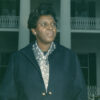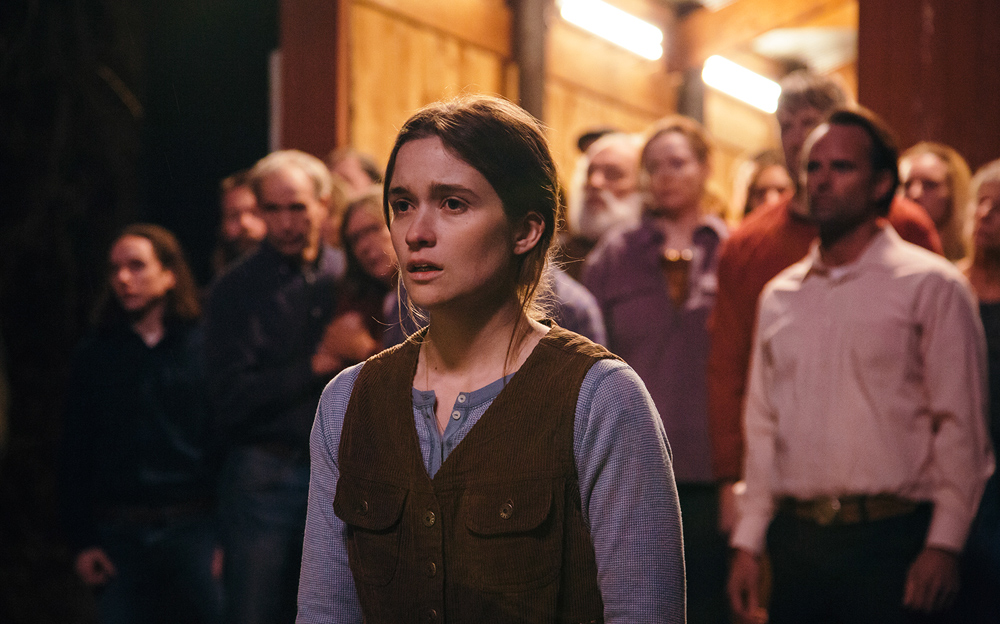When Garth Stevenson goes into a film scoring session, he doesn’t see it as all that much different than when he performing at clubs as part of a jazz quartet.
“When you get on stage with three other musicians and provide the whole concert is just to be as sensitive as possible to your fellow musicians and also to the audience that’s in the room, really being open to the moment and what could happen,” says Stevenson, a bassist by trade. “My first time watching through a film now, I’m much more sensitive to what’s going on with the characters and the emotions, and my goal is always how sensitive can I be?”
Stevenson’s attentiveness has led to unusually resonant scores, often galvanizing in how they establish a strong sense of place for characters to emerge from to find their inherent rhythm separate from their environment, whether it’s his collaborations with the director John Curran (“Chappaquidick” and “Tracks”) or his adventurous work in frigid conditions such as Miranda de Pencier’s “The Grizzlies,” set in the remote Nunavut region of Canada, or “Red Knot,” Scott Cohen’s Antarctica-based drama. It’s no wonder then that he got the call from “Them That Follow” co-directors Britt Poulton and Dan Madison Savage to compose for their debut feature, set in the heart of Appalachia where Mara (Alice Englert), the daughter of a Pentecostal Church pastor (Walton Goggins), is faced with the unfortunate predicament of either going through with an unwanted marriage with a member of the church (Lewis Pullman) or informing her family that she’s pregnant by way of a former member who’s been excommunicated (Thomas Mann).
When Goggins’ preacher Lemuel isn’t putting the fear of God into his flock with fire and brimstone sermons, he brings out snakes and Stevenson sonically summons the sensation of the slithery reptiles tightening their grip around you with a cacophony of different sounds coming from all directions as the filmmakers put the squeeze on Mara’s soul. At once immediate yet echoing centuries of generations past, Stevenson’s score contributes mightily to what makes “Them That Follow” so transporting when Mara herself is caught between joining the modern world and adhering to old traditions and with the thriller now in theaters, Stevenson spoke about how he was able to create something new from reclaimed church pipes, connecting with the energy actors are giving him and evading cliches in bringing Appalachia to the screen.
When you first talk to Dan and Britt, what were the initial conversations about?
Right off the bat, Dan and Britt said, “Hey, we love your music” and they just painted such a beautiful and complex picture just through the script alone, so I was really excited to work on it and they gave me a lot of creative freedom. We were more talking about the characters and the feelings of being inside the church [than the music] and some general ideas of trying not to didn’t want to demonize this religion being practiced at all. We wanted to capture the intensity of the moment, especially when the snake brought its own rules, but we wanted to be careful not to send it in the wrong direction.
It would’ve been a little too on the nose I think to have traditional Appalachian music, but I did try to use some instruments in an unconventional way. I did use the dulcimer and then the fiddle, but definitely not played in the Appalachian tradition. Some of the guitar cues hinted at it a little bit, and I’ve played in some bluegrass bands and been around Appalachian music a decent amount, but it didn’t feel like the film needed that. Usually, the best way to talk about things with directors is to just send the music, so I started work very quickly, sending things back and forth.
I understand the snakes were a big influence on how you approached this. How did you figure out how to echo that sound?
When I read the script, I didn’t know much at all about snake handling, but I learned quite a bit and that was one of the most fun aspects of working on the score. I really wanted to make a unique sound to [reflect the] snakes properly and two or three years ago, I was upgrading my studio and it’s a much bigger space now, so I have a lot more room, and I have this bad habit of looking on Craigslist for instruments. Somebody was selling church organ pipes because a construction worker had salvaged them from a church in Framingham, Massachusetts that was being torn down and he was selling them as lumber. The thought of seeing these 150-year-old pipes chopped up to [use to build] a compost shed kind of killed me, so I went to these people’s house. [The seller] wasn’t there, but his kids were and they were on their phones and I said, “Hey, guys, do you mind if I go check out the pipes in the basement?”
There were probably about 50 of [organ pipes] down there and I spent probably about an hour trying to blow air through as many as I could to make sure I got all the right pitches. Some of them worked and some of them didn’t, but I just tried to put myself in the shoes of the people upstairs, like “Who is this random guy from Craigslist, blowing in all these dusty wooden pipes?” [laughs] Some are three feet tall and the largest ones are seven feet and they’re tall, wooden, rectangular and pipes that [have] a metal cap like a mouthpiece on top – I realized after the fact that they’re lead, so I was telling Dan and Britt that I really gave a lot of myself to the film. And I had them sitting in the studio for a couple years waiting for the right opportunity to use them and then this came about.
I wanted a lot of different organ sounds. I used two electric organs, both a Hammond and a pump organ and then I wanted to record the pipes and the problem was they require so much air. Traditionally in a church, there’d be a giant blower down in the basement or the building next door, so I went to Home Depot and got an air compressor and then set up about eight microphones around the room and spent two or three days experimenting with blowing compressed air through the pipes. It was interesting because a traditional blower has really low air pressure it delivers through the pipes, but an air compressor is higher pressure, so it has this really kind of loud pitch to it which you can imagine coming out of a hose of compressed air, and it was the combination of that hitting the pipes created the sound for the snakes. It’s like any wind instrument. If you’re playing a flute, depending on where you focus the air, you can get all these different overtones coming out.
That was the first thing I worked on for the film. I remember the studio was a mess. There were pipes everywhere, and I was asking myself, is this the right decision? You just chewed up three days, but then when I finally found the sound, I knew it was and it was such a nice creative way to start the process.
The film builds to a major crescendo built from a variety of themes you create throughout the film for different characters. Do you think at all about the big moment before creating the individual strands?
Every film I work on is different and some come together in a very linear fashion, working from beginning to the end and others, you discover this theme three-quarters of the way through that you can adapt back to earlier in the film. But I’m always very conscious to be jumping back and forth from micro and macro, so I’m really obsessed and particular with the tiny details and then try to take five steps back and be, “Okay, where are we?” I do know that the final scene in the church when I worked on that, I got it to a place where it felt like it was a 9.5 out of 10 for intensity and it just felt like it needed that extra push, so we tried to get it up to an 11 and I think we got there.
In the theater I saw it in, it felt like at least a 12.
Okay, great. That’s one of my favorite scenes too because there’s something about it with the kind of percussion going on in the background, it’s not in a rigid meter, but at least to my ear, coming from a free jazz background that I come from, there’s kind of a groove to it that you can’t really [put your finger on] but you can feel it. I love all the metal – I was banging on like full metal shelving and scrap metal and triangles and I had some rattlesnake rattles, so there’s kind of this swarm of all these different instruments and overlapping rhythms that just gave it this pulsing intensity, but it wasn’t really in a set tempo.
[Sundance] was really my first time seeing it on a big screen with a big audience and it was so nice to experience that and little things, like I’ve noticed like, “Oh, I didn’t think people were going to laugh at that part, but they did. There was one moment when all 1200 people in the theater flat out screamed in perfect unison…I’m guessing I know which one that is.
Yeah, you probably know. [laughs] I had watched that moment hundreds of times trying to get it just right, but I wasn’t even thinking, “Oh, people might gasp or scream at this moment,” so to hear that kind of perfect unison and scream choir happen, it was great. It was successful at what we were trying to get across.
What was Sundance like overall for you?
It was so, so good. In the back of my mind, I usually have all these nitpicky notes about the mix, like “too bad this happened” or “oh, I wish this had been louder.” “What happened to that piano note?” But what happened when I sat down and watched this in the Eccles Theater, the whole time I was really happy with the way the film was mixed and the music really became a character. And it was so nice meeting all the cast, even hanging out for a bit with Walton Goggins, I feel like the way his acting was throughout the film, especially those scenes in the church, was just so rich and I was trying so hard to get his character right, and it’s interesting because from my improvising background, I would be playing my bass along to what he’s doing, just getting what you think someone is trying to convey. Then when I saw him, I was just thanking him for giving such a good performance – it was so juicy to work on – and he gave me a giant bear hug, like “You nailed it. You got what I was going for.” It was really fulfilling. Those are the kind of interactions that happen, even if it’s a year apart from when he acted it to when it was scored, [where] it’s nice to have those moments of connection.
“Them That Follow” is now open in limited release.




